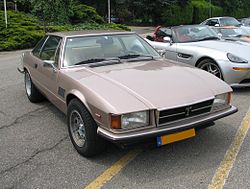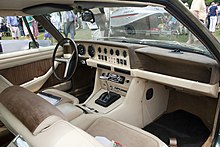De Tomaso Longchamp
| De Tomaso | |
|---|---|
|
De Tomaso Longchamp
|
|
| Longchamp | |
| Production period: | 1972-1989 |
| Class : | Sports car |
| Body versions : | Coupé , convertible |
| Engines: |
Petrol engines : 5.8 liters (199–243 kW) |
| Length: | 4600 mm |
| Width: | 1830 mm |
| Height: | 1295 mm |
| Wheelbase : | 2600 mm |
| Empty weight : | 1815 kg |

The De Tomaso Longchamp is after Pantera the most durable model of the former Italian car manufacturer De Tomaso . It was a sports coupé that was intended to appeal to a broader group of buyers and ensure the continued survival of the brand; later a convertible version was added. The Longchamp is technically related to the Maserati Kyalami .
The concept
The initiative for the Longchamp went back to the American Ford Motor Company, with which de Tomaso already had contractual relationships regarding the production and distribution of the high-volume Pantera model . Lee Iacocca , a leading Ford manager, had spoken admiringly of European design at a meeting with Alejandro de Tomaso in 1969 and was considering adding a Gran Turismo to Ford's official import program in addition to the Pantera mid-engined sports car . Alejandro de Tomaso, who saw this as an opportunity to expand his company's range of models, then commissioned the development of the Longchamp. The car was to compete with the Mercedes SL , the dimensions of which it was based on.
The concept of the Longchamp came from Alejandro de Tomaso himself. In addition to specific ideas about the layout, this also included the requirement to take as many components as possible from the sister models Pantera and Deauville that had already been developed . Accordingly, the chassis of the Deauville sedan designed by Giampaolo Dallara was also used for the Longchamp ; however, it was shortened by 18 centimeters. For this floor pan, the American designer Tom Tjaarda , who was the only designer of the Carrozzeria Ghia at the time, designed a two-door, four-seater body.
For reasons of cost, many technical components were taken over from large-scale manufacturers: the steering column came from the Lincoln Continental , the power steering came from Cam Gears. De Tomaso obtained the differential from Salisbury , the rear axle construction was copied by de Tomaso's engineers from the Jaguar XJ6 . The engine was - as in the Pantera - a Ford Cleveland eight-cylinder with 5.8 liters (5769 cm³) displacement. The C-6 Cruise-O-matic automatic also came from Ford; A five-speed manual transmission from ZF was installed in a total of 17 cars .
Various attachments also came from other manufacturers. The headlights, for example, were components that were initially used on the European Ford Granada . The rear lights came from the Alfa Romeo 1750/2000 . Overall, the 1.8-ton car was designed more for comfort than sportiness. This approach was matched by extensive standard equipment, which included electric windows, air conditioning and leather upholstery.
As usual, de Tomaso did not build the Longchamps entirely himself. The body shell was first assembled at Ghia before it was sent to De Tomaso in Modena for final production . After the break in relations with Ford, de Tomaso hired other bodyworks to manufacture the Longchamp. From 1979 the bodyshells were manufactured at Embo in Turin . The largely identical Maserati Kyalami was also built there .
The prototype
In 1973 the prototype of the Longchamp was completed at the Golden Car Company in Caramagna Piemonte . The car presented shortly thereafter was named Longchamp , named after the Longchamp racecourse in Paris . During the first test drives, it convinced the journalists with healthy driving performance (240 km / h) and a successful chassis that was considered to be on par with that of the Mercedes SL and its close relatives 450 SLC. However, no test report forgot to mention the simple origin of the American engine.
The first series
Production of the first series began in 1973. While the prototype (as the only copy) was given a 1000 chassis number, the vehicles in the first series had 2000 numbers. The first series of the Longchamp was produced until 1979. Contrary to initial expectations, soon after the presentation, Ford decided not to import the Longchamp into the USA at the factory. Possibly this was due to the considerable quality defects that the American Lincoln-Mercury dealers had to contend with at the Panteras . In any case, this decision meant that the production of the Longchamp fell far short of the initial targets. Various Longchamps were imported into the USA, but these imports were based on de Tomaso himself or on independent importers.
When de Tomaso took over Maserati in 1975, he saw an opportunity to increase the spread of Longchamp design. He had Pietro Frua redesign the Longchamp at short notice . Together with single headlights, taillights from the Citroën SM and Maserati's own eight-cylinder, the Longchamp's twin brother, known as the Maserati Kyalami , was created in a very short time . The kyalami was not a success. The clearly recognizable proximity to De Tomaso Longchamp and its not very elegant body for Maserati standards stood in the way of better sales.
In 1978 the German trade magazine Auto Motor und Sport tested a Longchamp with manual transmission that was delivered to Germany. In the 10/1978 issue the report "Halbblut" appeared, which on the one hand praised the performance, the external understatement and the space available of the coupé, but on the other hand also criticized defects such as unusable windshield wipers, unfavorable operation and careless workmanship. Overall, the car is characterized more by improvisation than by perfection.
The second series
From 1979 the Longchamp was built in a second series, for which 3000 chassis numbers were assigned. There were various minor changes. From a technical point of view, the position of the engine was modified, the front axle geometry revised and a steering gear installed for a better turning circle. The interior now received seats with attached headrests. Instead of the slide control, the heating control now got three rotary switches, all of which were marked with the De Tomaso logo. From the end of 1979, much wider plastic bumpers were installed. From 1982 the cars got the headlights from the Audi 80 ; Upon request, four rectangular double headlights and bumpers painted in the body color were later available. In 1982 the interior was adapted to the opulent style of the contemporary Maseratis : the dashboard was clad in real wood and the interior parts of the doors were covered with gathered leather.
From 1979 a GTS version with a decidedly sporty appearance was available. The first GTS version was delivered in November 1979. It had hand-operated steel fender flares and an electric sunroof. It had the chassis number # 3059. The bodywork was carried out by Carrozzeria Campana in Modena. Later the fender flares were made from GRP.
The last Longchamp was manufactured in 1986, but the sale lasted until 1988. According to the factory, a total of 414 Longchamps were built, most of them in a Series 1 configuration. There was no successor.
De Tomaso Longchamp Spyder
In 1981, a convertible with the name Spyder was added as a further body variant . The vehicle was based on a study that Pietro Frua had developed for the Maserati Kyalami in 1978. While the Kyalami Spyder remained a one-off, the open version of the Longchamp was created in a small series. De Tomaso had the work carried out for this at Carrozzeria Pavesi in Milan , who had already built several Targa versions of the Pantera. A total of 14 factory convertibles were produced, the silver prototype of which was driven through the Italian countryside by Ornella Muti in the Adriano Celentano film The Tamed Shrew . Pavesi and other coachbuilders also retrofitted several older coupés into convertibles.
Tuning
Although there were a number of ways to customize the Longchamp at the factory, individual independent tuners also dealt with the car. The best known was the company Jehle in Schaan , Liechtenstein , which not only sold bodywork components and wanted to increase the engine output to up to 1000 hp using turbo or biturbo designs, but also wanted to increase the environmental compatibility of the Longchamp by installing catalytic converters . However, these offers were only announcements. No Longchamp with such modifications has been delivered anywhere in the world.
literature
- Georg Amtmann, Halwart Schrader: Italian sports cars. 1st edition. Motorbuch-Verlag, Stuttgart 1999, ISBN 3-613-01988-4 .
- auto motor und sport 10/1978: half blood



